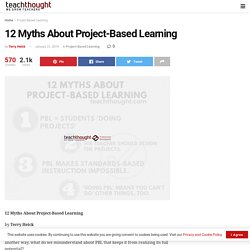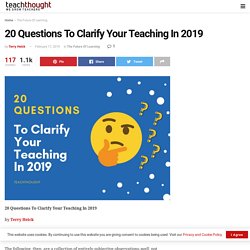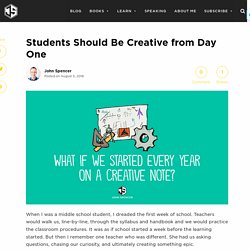

Against Persuasion. Gold Standard PBL: Essential Project Design Elements. It’s encouraging that Project Based Learning is becoming popular, but popularity can bring problems.

Here at the Buck Institute for Education, we’re concerned that the recent upsurge of interest in PBL will lead to wide variation in the quality of project design and classroom implementation. If done well, PBL yields great results. But if PBL is not done well, two problems are likely to arise. First, we will see a lot of assignments and activities that are labeled as “projects” but which are not rigorous PBL, and student learning will suffer.
Or, we will see projects backfire on underprepared teachers and result in wasted time, frustration, and failure to understand the possibilities of PBL. Seven Myths Keeping Teachers from Implementing Creative Projects. Choice page. Time. 12 Myths About Project-Based Learning - 12 Myths About Project-Based Learning by Terry Heick Simple premise: What are the most common myths about project-based learning?

Put another way, what do we misunderstand about PBL that keeps it from realizing its full potential? At TeachThought, we’re proponents of project-based learning as one of countless progressive learning models that can grow teachers–and thus grow the minds and potential of students. 10 Reasons Every Teacher Needs A Professional Learning Network -
10 Reasons Every Teacher Needs A Professional Learning Network by TeachThought Staff What’s a professional learning network? According to Marc-André Lalande, “a Personal Learning Network is a way of describing the group of people that you connect with to learn their ideas, their questions, their reflections, and their references. Your PLN is not limited to online interactions, but it is that online, global interactive part that really makes it special. It is personal because you choose who’s part of that group; you choose if you want to lurk–just check out what people are saying–or if you share; because you choose when to do so, and how to do so.” 18 Extraordinary Questions Education Faces In 2015. 20 Questions To Clarify Your Teaching In 2019 by Terry Heick Who knows where education is going, but it’s not impossible to come up with some questions that might guide that evolution.

The following, then, are a collection of entirely subjective observations–well, not entirely subjective I guess. Or not any more than anyone else. Students Should Be Creative from Day One. When I was a middle school student, I dreaded the first week of school.

Teachers would walk us, line-by-line, through the syllabus and handbook and we would practice the classroom procedures. It was as if school started a week before the learning started. But then I remember one teacher who was different. She had us asking questions, chasing our curiosity, and ultimately creating something epic. Each day, I felt like I had entered a new world.
A Guide To Questioning In The Classroom. An Updated Guide to Questioning in the Classroom by TeachThought Staff Something we’ve become known for is our focus on thought, inquiry, and understanding, and questions are a big part of that.

We’ve done questions that students should ask, parents should ask, students should and shouldn’t answer, questions that promote and stifle inquiry, questions that reveal self-knowledge and wisdom, and more. If the ultimate goal of education is for students to be able to effectively answer questions, then focusing on content and response strategies makes sense. The Evil Genie Problem. 4 Characteristics Of Critical Digital Pedagogy. How Helping Students to Ask Better Questions Can Transform Classrooms. To get started with the QFT, first give students time to develop as many questions as they can, with the instruction not to worry if it’s a “good or bad” question. The only requirement is that they be questions, not statements. After the initial fast brainstorm, talk about the difference between closed and open questions, discussing the advantages and disadvantages of both.
Then ask students to categorize their questions as “open” or “closed.” The next step is to ask students to change some of their questions from open to closed and vice versa. 50 Alternatives To Lecturing. 5 Ideas for Keeping Students At The Center of Learning #TLTechLive. For those who work in the field of education, it seems obvious that we would keep students at the center of all that we do, but often this is forgotten.

When it is forgotten students suffer. So how do we make sure we put students at the center of all we do? 4 Principles Of Student-Centered Learning. By TeachThought Staff A Definition of Student-Centered Learning In our view, student-centered learning is a process of learning that puts the needs of the students over the conveniences of planning, policy, and procedure.

How to Help Students Ask Better Questions by Creating a Culture of Inquiry. Edutopia. Great ideas can lose their allure when not implemented well. But that doesn’t make them bad ideas. Such is the case with project-based learning (PBL), a complex, powerful approach to teaching and learning that’s backed by extensive research. In my work supporting PBL implementation in schools and districts, I sometimes run into teachers and administrators who have been turned off to PBL. Ww2.kqed. Edutopia. However, while I was clearing my credential, working with mentor teachers to reflect on my practice, and finding out how real students differed from theoretical ones, I also spent long hours after school with the speech and debate team reading philosophy and theory and talking about innovative alternatives for national defense, natural resource allocation, and, of course, education.
That led me to some uncomfortable conclusions. Although I encouraged my students to think critically and challenged myself to develop new methods of instruction, the actual conduct of the class seemed at odds with all that. I wanted my students to do more than just follow rules handed down to them. I wanted them to understand why those rules exist, and be willing to interrogate ones that didn’t seem valuable, meaningful, or useful. Getting Started. 50 Crazy Ideas To Change Education. 50 Crazy Ideas To Change Education by Terry Heick Below are 50 ideas for a new education.

Note, most of these are about education as a system rather than learning itself, but that’s okay. It’s often the infrastructure of learning that obscures anyway. The Innovative Educator: It’s Class Load, Not Just Size, That Matters. As the school year launches for students across the nation, questions from passionate and innovative educators come into my networks on how to effectively support student learning.

One common thread comes from innovative educators who have several classes of students and are trying to figure out how to manage all the demands placed upon them. They know that learning is not effective if you don't get to know your students. Or, as Jeff Bliss reminded us a few years back, you need to touch a student’s freakin heart before you can reach their minds. There are definitely ways technology can help with this. Collaborative Projects Can Work in Any Subject - John Spencer. If we say we want students to become critical thinking life-long learners, we need to provide projects that encourage them to engage in creative collaboration.

But what does this look like in each subject area? How do turn this idea into a reality? We’ll be exploring that idea in my second blog post in a second in a series about how to take collaborative projects to the next level. Why I Won’t Be Using Common Formative Assessments This Year. Why I Won’t Be Using Common Formative Assessments This Year Although I’ve only taught in the classroom for six years, I’ve been around long enough to observe trends in education. For instance, I’ve watched Paul Tough and the No Excuses movement catapult grit, the notion that all it takes to succeed is perseverance, from a charter school mainstay to the NAEP and the national stage. Another current trend in schooling is Carol Dweck’s growth mindset theory. In a nutshell, Dweck argues that ability is more important than innate talent.
6 Critical Thinking Questions For Any Situation - 28 Critical Thinking Question Stems For Any Content Area - What Kind Of Student Should School Produce? - 6 Questions Students Can Use To Guide Their Inquiry-Based Learning - 4 Things All Project-Based Learning Teachers Should Do. 10 Benefits Of Inquiry-Based Learning. How Action Research Sparks Innovation and Boosts Creativity in the Classroom – John Spencer. 5 Absurd Myths About Critical Thinking - 20 Observable Characteristics Of Effective Teaching - Tapping Into the Adolescent Need For Purpose to Motivate Learners. 8 Basic Steps Of Project-Based Learning To Get You Started - 14 Messages Every Student Needs To Hear From You - 6 Strategies for Differentiated Instruction in Project-Based Learning. Five Ways to Engage Reluctant Learners – John Spencer. Social Justice Projects in the Classroom. 10 Reasons Every Teacher Needs A Professional Learning Network -
A 3 Dimensional Model Of Bloom's Taxonomy - Digital Promise Puts Education Research All In One Place. A Diagram Of Pedagogy in the 21st Century - 12 Things That Will Disappear From Classrooms In The Next 12 Years. A Linear Scale For Critical Literacy. Are We Missing the Point with Digital Citizenship? Oakland Schools Literacy. Henry James and H.G. Well’s Famous Feud About Writing, the Purpose of Art, and the Usefulness of Literature. Top 10 Tools for a Free Online Education. Standards, Grades And Tests Are Wildly Outdated, Argues 'End Of Average' : NPR Ed. Three Examples of Students Creating Real-World Products to Solve Problems That Mattered to Them. Helping Students Write Beautiful Words. The 10 Skills Modern Teachers Must Have. Modern Professional Learning: Connecting PLCs With PLNs.